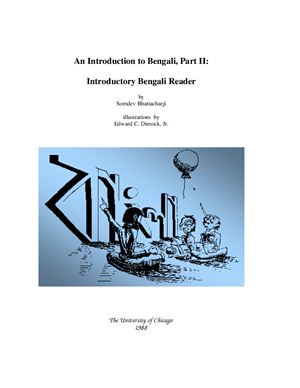Bhattacharji S. An introduction to Bengali, part II. Introductory
Bengali reader. - The University of Chicago, 1988. - 216 p.
The Introductory Bengali Reader represents a thorough revision of the work first produced by this writer in September, 1959. The revision has been made on the basis of two years of classroom work and incorporates suggestions and criticisms of several scholars who read the previous edition.
There are several excellent graded Bengali readers for the native speakers of Bengali, but the problem of a non-native speaker, in particular that of a foreigner leaing the language, is very different; for him these readers are not quite adequate.
The Introductory Bengali Reader differs in emphasis and approach from the others. Like the grammar,1 which has been designed to accompany this reader, it is aimed at a compromise between purely structural and purely cultural approaches. It is primarily based on the following premises: (i) the reading material of a foreign language text, even the most elementary book, must not only be graded but also meaningful and interesting; (ii) the material should give the student a greater appreciation of the life, ways of thinking, culture, and history of the people whose language he is reading; (iii) the material should be so graded and so presented that the student feels that he is leaing the language with ease and pleasure rather than struggling through it; (iv) since the relationship between Bengali orthography and pronunciation is not always directly obvious, the student should be given, wherever possible, general rules as a guide to
pronunciation; (v) when the student completes the reading of this material, he should feel ready to read the works of the eminent authors incorporated in A Bengali Prose Reader for Second-Year Students, edited by Edward C. Dimock, Jr. and this writer.
The Introductory Bengali Reader represents a thorough revision of the work first produced by this writer in September, 1959. The revision has been made on the basis of two years of classroom work and incorporates suggestions and criticisms of several scholars who read the previous edition.
There are several excellent graded Bengali readers for the native speakers of Bengali, but the problem of a non-native speaker, in particular that of a foreigner leaing the language, is very different; for him these readers are not quite adequate.
The Introductory Bengali Reader differs in emphasis and approach from the others. Like the grammar,1 which has been designed to accompany this reader, it is aimed at a compromise between purely structural and purely cultural approaches. It is primarily based on the following premises: (i) the reading material of a foreign language text, even the most elementary book, must not only be graded but also meaningful and interesting; (ii) the material should give the student a greater appreciation of the life, ways of thinking, culture, and history of the people whose language he is reading; (iii) the material should be so graded and so presented that the student feels that he is leaing the language with ease and pleasure rather than struggling through it; (iv) since the relationship between Bengali orthography and pronunciation is not always directly obvious, the student should be given, wherever possible, general rules as a guide to
pronunciation; (v) when the student completes the reading of this material, he should feel ready to read the works of the eminent authors incorporated in A Bengali Prose Reader for Second-Year Students, edited by Edward C. Dimock, Jr. and this writer.

